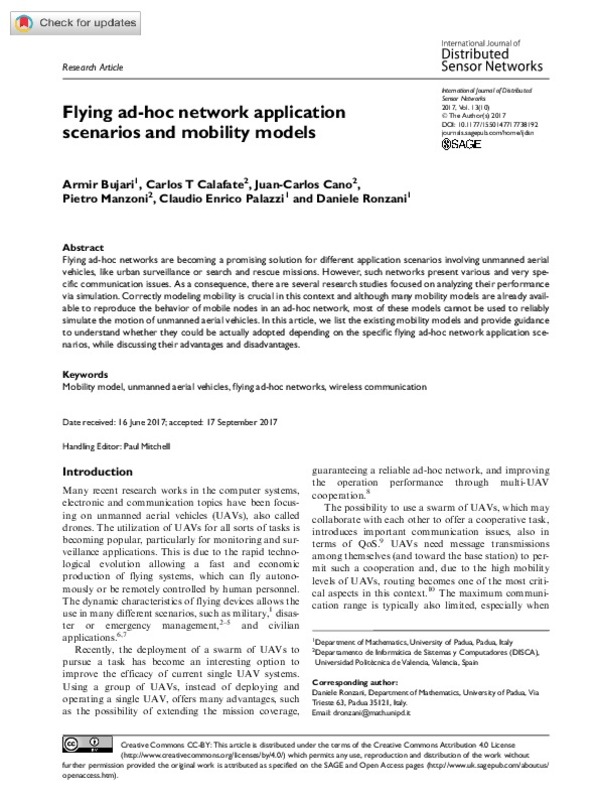JavaScript is disabled for your browser. Some features of this site may not work without it.
Buscar en RiuNet
Listar
Mi cuenta
Estadísticas
Ayuda RiuNet
Admin. UPV
Flying ad-hoc network application scenarios and mobility models
Mostrar el registro sencillo del ítem
Ficheros en el ítem
| dc.contributor.author | Bujari, Armir
|
es_ES |
| dc.contributor.author | Tavares de Araujo Cesariny Calafate, Carlos Miguel
|
es_ES |
| dc.contributor.author | Cano, Juan-Carlos
|
es_ES |
| dc.contributor.author | Manzoni, Pietro
|
es_ES |
| dc.contributor.author | Palazzi, Claudio Enrico
|
es_ES |
| dc.contributor.author | Ronzani, Daniele
|
es_ES |
| dc.date.accessioned | 2018-03-23T13:29:51Z | |
| dc.date.available | 2018-03-23T13:29:51Z | |
| dc.date.issued | 2017 | es_ES |
| dc.identifier.issn | 1550-1329 | es_ES |
| dc.identifier.uri | http://hdl.handle.net/10251/99665 | |
| dc.description.abstract | [EN] Flying ad-hoc networks are becoming a promising solution for different application scenarios involving unmanned aerial vehicles, like urban surveillance or search and rescue missions. However, such networks present various and very specific communication issues. As a consequence, there are several research studies focused on analyzing their performance via simulation. Correctly modeling mobility is crucial in this context and although many mobility models are already available to reproduce the behavior of mobile nodes in an ad-hoc network, most of these models cannot be used to reliably simulate the motion of unmanned aerial vehicles. In this article, we list the existing mobility models and provide guidance to understand whether they could be actually adopted depending on the specific flying ad-hoc network application scenarios, while discussing their advantages and disadvantages. | es_ES |
| dc.language | Inglés | es_ES |
| dc.publisher | SAGE Publications | es_ES |
| dc.relation.ispartof | International Journal of Distributed Sensor Networks | es_ES |
| dc.rights | Reconocimiento (by) | es_ES |
| dc.subject | Mobility model | es_ES |
| dc.subject | Unmanned aerial vehicles | es_ES |
| dc.subject | Flying ad-hoc networks | es_ES |
| dc.subject | Wireless communication | es_ES |
| dc.subject.classification | ARQUITECTURA Y TECNOLOGIA DE COMPUTADORES | es_ES |
| dc.title | Flying ad-hoc network application scenarios and mobility models | es_ES |
| dc.type | Artículo | es_ES |
| dc.identifier.doi | 10.1177/1550147717738192 | es_ES |
| dc.relation.projectID | info:eu-repo/grantAgreement/MINECO//TEC2014-52690-R/ES/INTEGRACION DEL SMARTPHONE Y EL VEHICULO PARA CONECTAR CONDUCTORES, SENSORES Y ENTORNO A TRAVES DE UNA ARQUITECTURA DE SERVICIOS FUNCIONALES/ | es_ES |
| dc.rights.accessRights | Abierto | es_ES |
| dc.contributor.affiliation | Universitat Politècnica de València. Departamento de Informática de Sistemas y Computadores - Departament d'Informàtica de Sistemes i Computadors | es_ES |
| dc.description.bibliographicCitation | Bujari, A.; Tavares De Araujo Cesariny Calafate, CM.; Cano, J.; Manzoni, P.; Palazzi, CE.; Ronzani, D. (2017). Flying ad-hoc network application scenarios and mobility models. International Journal of Distributed Sensor Networks. 13(10):1-17. doi:10.1177/1550147717738192 | es_ES |
| dc.description.accrualMethod | S | es_ES |
| dc.relation.publisherversion | https://doi.org/10.1177/1550147717738192 | es_ES |
| dc.description.upvformatpinicio | 1 | es_ES |
| dc.description.upvformatpfin | 17 | es_ES |
| dc.type.version | info:eu-repo/semantics/publishedVersion | es_ES |
| dc.description.volume | 13 | es_ES |
| dc.description.issue | 10 | es_ES |
| dc.relation.pasarela | S\351127 | es_ES |
| dc.contributor.funder | Ministerio de Economía, Industria y Competitividad | es_ES |








